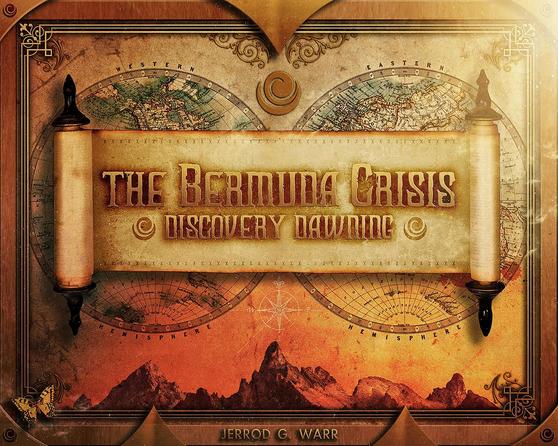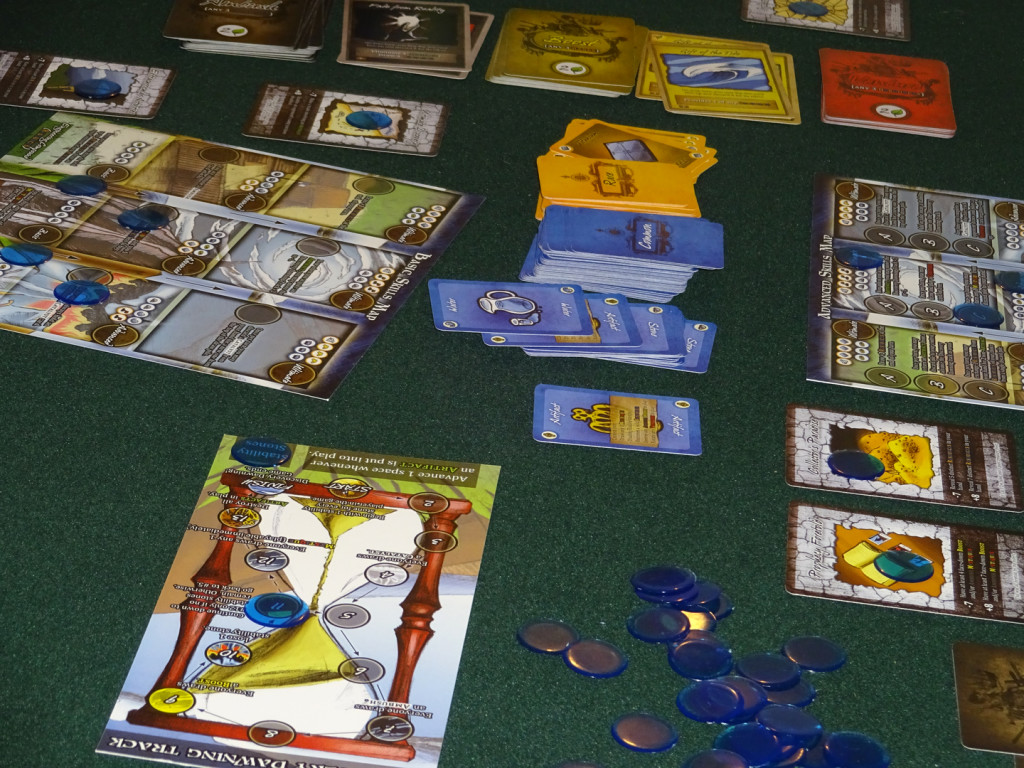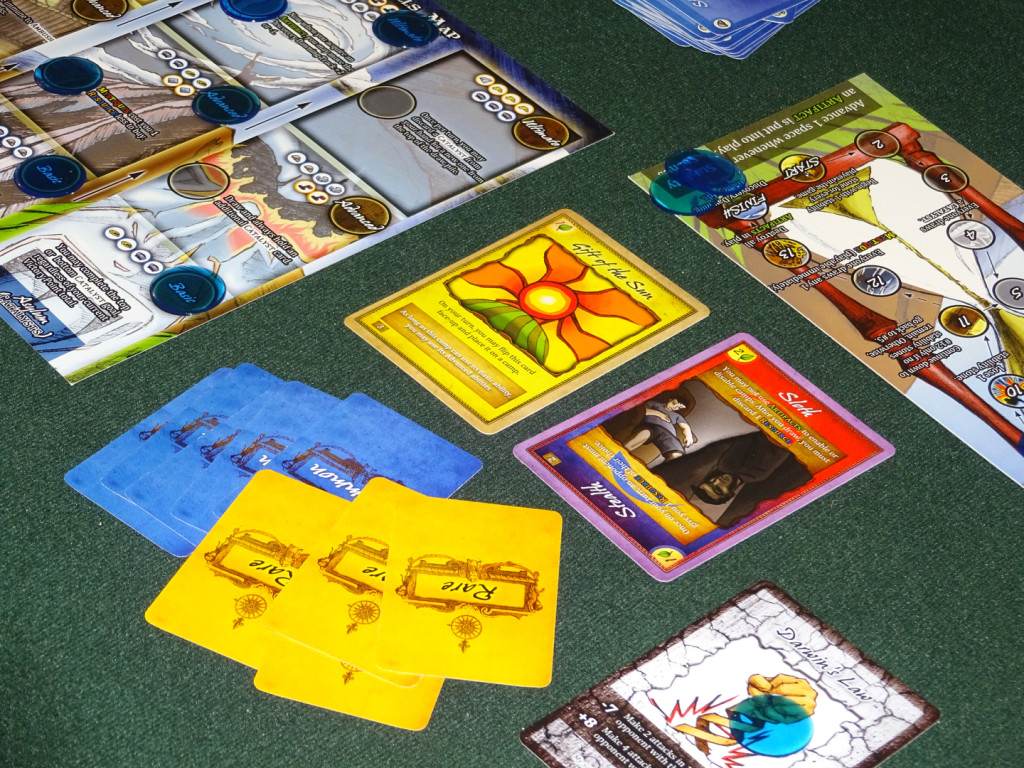I can’t tell you how many conspiracy theories I’ve heard regarding the Bermuda Triangle. While some of them are pretty far out there, it can admittedly be fun to think of the mysteries that surround it. “The Bermuda Crisis”, a game that’ll be hitting Kickstarter sometime in January of 2016, puts players in the shoes of competing teams exploring an undisclosed island inside the Bermuda Triangle. Your goal will be to collect treasures in the form of resources, magic, artifacts, and other goodies whilst trading, managing vendettas, and building base camps. Before we get started, I’d like to thank game creator Jerrod Warr for providing me with a prototype copy for preview purposes. It’s important to stress that prototypes are not often reflective of the final product, making everything you read about in this article (including the rules) subject to change.

My prototype copy came with resource cards (a type of currency), mystique cards (magic abilities), catalyst cards (secret objectives), Brinehorn’s Scroll (an alternate victory condition), skill maps (tracks acquired abilities), a discovery dawning track (an in-game timer), and some plastic chips (victory points and other miscellaneous tracking). The artwork in my copy was nicely themed and sharp to boot. The shades of colors used could definitely attract attention from across a room. Again, it’s worth stressing that the final production copies may look different from my prototype. For that reason, I pulled the pictures in this preview directly from the developer’s website and Facebook page in order to better represent the game.
To quickly overview game setup, each of the decks are shuffled separately and organized by their groups (resources = common and rare, mystiques = ambush, boost, and venture, and catalyst cards are by themselves). Each player gets a basic skills map, three common resources, and one rare resource. Any artifacts or Brinehorn’s Scroll pieces are placed back into the deck, with the player drawing more until they only have resources. The discovery dawning track’s sliding chip goes on the start circle and one chip per player goes on the stability stone space. A starting player is chosen at random with play proceeding clockwise.
Describing the rules of the game is going to be somewhat of a challenge as they’ll change throughout. To sum up the very basic of rules however, a player can do any of the following in any order on their turn:
1. Build or upgrade camps by discarding resources. This earns them victory points, tracked via the skills map.
2. Buy one mystique card from any of the three draw piles. Venture cards are immediately played face-up.
3. Activate any number of camp and venture abilities you’ve acquired that would create actions.
4. Play ambush or boost cards.
5. Use artifacts.
6. Initiate a trade.

Players then end their turn by drawing four resources (common or rare). Brinehorn’s Scroll pieces and artifacts are placed up in front of them, the latter of which advances the discovery dawning track. The game continues until someone acquires fourteen victory points, the discovery dawning track reaches the “finish” space, or when a player acquires all three pieces of Brinehorn’s Scroll. In the case of time running out, whoever has the most nature points in front of them wins.
To quickly sum up the above, players are aiming to collect resources and acquire abilities in order to help them earn themselves victory points. Building a basic camp on your skill map, for example, is worth one victory point. There are advanced and ultimate camp upgrades available that will net you more victory points AND new skills. By the by, there’s an “advanced” side to the skill map that players could opt to play with instead, allowing them to choose which advanced and ultimate upgrade abilities they’ll receive. For obvious reasons, new players should stick to the basic side of the skill map until they get a few games under their belt.
You can also use catalyst cards to gain victory points and I personally like the way they’re handled. For starters, there are actually two goals listed on each card. The number of chips you have will determine which one you’ll need to accomplish in order to gain another one. If you’re really far ahead and have a good number of victory point chips already, for example, then you’ll probably be observing objectives with the “8+” next to it. When accomplished, you’ll reveal the goal, gain a victory point chip, and draw a new catalyst card. These cards aren’t necessary to win, but they’ll help you reach that fourteen victory point goal.
Artifacts are pretty interesting too, giving players a wide range of abilities. They can act as a wild resource, for example, when buying or building. They can also allow you to draw one mystique card without having to spend resources. If you feel like you want to ruin someone else’s day, you can disable entire camps and their associated abilities, destroy face-up/face-down ambush or boost cards, or rotate any one of a player’s venture cards. While cool to see while they’re in front of you, they will advance time on the discovery dawning track. They are discarded after use except when disabling camps.

By now you’ve seen me refer to ambush, boost, and venture cards, all of which fall under the “mystique” card set. Each deck does something different. Ambush cards cost three common resources to purchase and specialize in attacking other players. The “Tainted Water” card, for example, forces all players to give you one of their resources. Boost cards cost three rare resources and are primarily used for defense and gaining resources. “Gift of the Tide”, for instance, grants any one resource to the user. Lastly, venture cards are permanents that can be either helpful or downright nasty, depending on what side they’re rotated to. It starts rotated to the positive (blue) side after being purchased ( requires three resources), but can be rotated again via an artifact throughout the game. Players earn nature points when playing these cards.
Needless to say there’s more to the game than I covered here, but hopefully this gives you a good idea as to what you’d be in for should you decide to support the game during its Kickstarter campaign. “The Bermuda Crisis” certainly gives players a lot of options, but it does a good job of easing them into it. In the beginning of the game, you’ll find yourself taking very few actions and instead focusing on the collection of resources. You won’t really have anything to worry about until you have several camps, artifacts, and other cards in play. In other words, the progression is pretty beginner-friendly. At the very least, this one’s worth checking out.
—
You can learn more about and support the game on Kickstarter, here:
https://www.kickstarter.com/projects/497772577/the-bermuda-crisis-explore-conspire-build-and-trad
